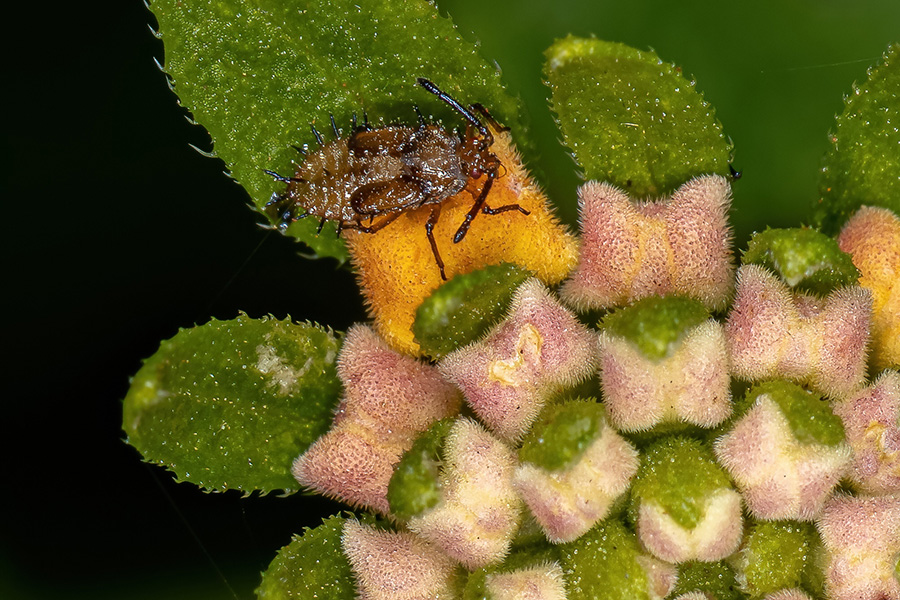Nursery and Ornamental Horticulture
-

The lantana lace bug, Teleonemia scrupulosa Stål (Tingidae: Hemiptera), is a serious pest of lantana (Lantana
camara L.). Although lantana is regarded as an invasive weed both in the United States and worldwide,
many popular cultivars continue to be planted in residential and public ornamental landscapes and gardens.
Previously, the lantana lace bug was deliberately introduced to several countries as a biological control agent for
lantana. Te lantana lace bug is also referred to as T. lantanae or T. vanduzeei in many publications. This publication covers the identification, biology, symptoms and management of lantana lace bugs.William G. Hudson and Shimat V. Joseph
|
-

The Greenhouse*A*Syst publication Series has been developed to assist greenhouse owners with the task of assessing three management issues: Water management, Environmental Risk and Business Profitability. This publication will also help you establish a water conservation document you may find useful if and when state or local water authorities develop policies or implement water restrictions. Most water authorities are favorably impressed with businesses that have developed water conservation plans.
Bodie V. Pennisi
|
-

The Greenhouse*A*Syst series of publications is a confidential self-assessment program you can use to evaluate your greenhouse business for risks associated with water management issues. Armed with facts and figures, you will then be able to reevaluate your management strategies and determine ways to conserve water and minimize those risks. By following the guidelines, you will be able to establish a formal company-wide water conservation plan. Implementing this plan will facilitate more efficient use of resources and impart significant savings in water use, fertilizer and pesticides.
Bodie V. Pennisi
|
-

B 1276
Water Management Assessment
The Greenhouse*A*Syst series of publications is a confidential self-assessment program you can use to evaluate your greenhouse business for risks associated with water management issues. Armed with facts and figures, you will then be able to reevaluate your management strategies and determine ways to conserve water and minimize those risks. By following the guidelines, you will be able to establish a formal companywide water conservation plan. Implementation of this plan will facilitate more efficient use of resources and impart significant savings in water use, fertilizer and pesticides. This publication will help you take a candid look at how you approach water management.
Bodie V. Pennisi
|
-

B 1277
Water Quality Assessment
The Greenhouse*A*Syst series of publications is a confidential self-assessment program you can use to evaluate your greenhouse business for risks associated with water management issues. Armed with facts and figures, you will then be able to reevaluate your management strategies and determine ways to conserve water and minimize those risks. By following the guidelines, you will be able to establish a formal companywide water conservation plan. Implementation of this plan will facilitate more efficient use of resources and impart significant savings in water use, fertilizer and pesticides. This publication will help you determine your water quality and help you develop a management plan to monitor your water quality.
Bodie V. Pennisi
|
-

The Greenhouse*A*Syst series of publications is a confidential self-assessment program you can use to evaluate your greenhouse business for risks associated with water management issues. Armed with facts and figures, you will then be able to reevaluate your management strategies and determine ways to conserve water and minimize those risks. By following the guidelines, you will be able to establish a formal company-wide water conservation plan. Implementation of this plan will facilitate more efficient use of resources and impart significant savings in water use, fertilizer and pesticides. This publication will help you assess the feasibility of water reclamation and recycling in your operation.
Bodie V. Pennisi
|
-

The Greenhouse*A*Syst series of publications is a confidential self-assessment program you can use to evaluate your greenhouse business for risks associated with water management issues. Armed with facts and figures, you will then be able to reevaluate your management strategies and determine ways to conserve water and minimize those risks. By following the guidelines, you will be able to establish a formal company-wide water conservation plan.
Implementation of this plan will facilitate more efficient use of resources and impart significant savings in water use, fertilizer and pesticides. This section will help you develop a plan to
conserve water resources and establish a company policy. It will also ask you to become more aware and involved in local water use legislation. By completing this section, you will reduce the risk of being caught off-guard by water shortages due to legislative and social issues in your community.Bodie V. Pennisi
|
-

This diagnostic system is designed as a tool to assist growers, Extension specialists and county agents to diagnose problems with ornamental crops. The document consists of six major sections and five appendices. Each section is designed to supply information on various important aspects of the crop under scrutiny.
Bodie V. Pennisi
|
-

Weed management is one of the most critical and costly aspects for container nursery production. High irrigation and fertilization rates create a favorable environment for weed growth in addition to crop growth. Weeds can quickly out-compete the crop for light and other resources, reducing the rate and amount of crop growth as well as salability. Weed management in nursery production is most effectively achieved by preventative practices, primarily with the use of pre-emergent herbicides. However, there are valid reasons for managing weeds using alternatives to synthetic herbicides. Weed management alternatives to synthetic herbicides include sanitation, exclusion, prevention, hand weeding, mulching and use of cover crops, heat and non-synthetic herbicides. Only some of these alternative methods can be used to control weeds in containers, but all can be used to manage weeds around containers and in non-crop
areas.Matthew Chappell
|